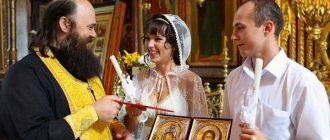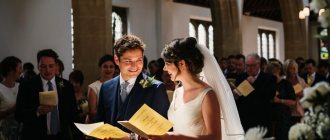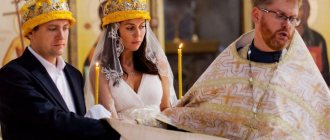The meaning of the sacred ritual
Orthodox Christians greatly honor marriage concluded in the presence of the Lord God, considering this union more important than the state one. Having received God's blessing, the newlyweds enlist the support of the Almighty in a married life full of love, mutual understanding and fidelity.
Today, newlyweds are increasingly confirming their official marriage with vows before the Lord God
The meaning of the sacrament is that a married couple continues to be such in Heaven, remaining inseparable even after death. Having made a marriage vow, the newlyweds seal themselves with sacred bonds, gaining Divine protection.
The most important conditions for the wedding ceremony
Before talking about the possibility of getting married and choosing a church, you need to figure out whether the church can get you married. The fact is that currently there are some conventions and rules that may stand in the way of registering a marriage at the highest level:
- You will not be married if you are related, the same applies to spiritual ties, that is, marriage cannot take place between a godmother and her godson, and so on.
- The bride and groom must be at least 18 years old
- If you've already been married three times, there won't be a fourth time.
- The wedding ceremony will be prohibited if you profess different religions
- If you do not have a mark of official marriage
- If one of the spouses has not broken off the previous marriage
- If one of the parties is an atheist
- If there is a large age difference between the future spouses (although not all Orthodox churches adhere to this rule).
For whom is the ritual prohibited?
In Russia, clergy do not have the right to perform a ceremony without first registering a marriage with government authorities. There are several other situations when weddings are prohibited:
- the newlyweds have not reached the age of majority;
- one of the couple changed gender;
- young people are relatives by blood or spirit;
- one of the spouses is not divorced at the time of the ceremony;
- atheists, adherents of another faith, or unbaptized people want to get married;
- people who have taken a vow of celibacy;
- incompetent;
- the husband or wife has had three or more divorces.
But for pregnant women it is not only possible, but even necessary, because the baby must be born in a divine union.
How to choose a date
Orthodox Christians living in Russia rarely manage to combine official painting with the sacrament of wedding. As a rule, a sacred ceremony is carried out after a certain time so that the newlyweds can test their relationship. The rite does not take place on the following days:
- Saturday;
- Tuesday;
- Thursday;
- Easter week;
- Maslenitsa;
- church holidays;
- fast;
- Christmas Holidays.
According to Orthodox believers, the best days for a wedding are:
- Our Lady of Kazan;
- Iveron Blessed Virgin Mary;
- Nicholas the Wonderworker;
- "Red hill".
In order not to make a mistake when choosing a date, we advise you to use a wedding calendar or contact your priest.
Author's advice
What should not be done after the wedding of spouses?
The requirements after the wedding do not differ from the requirements of general morality. There is no need to perceive a wedding as a duty or imposition of morality. A wedding is a marriage before God , so after the wedding you need to maintain the desire to live your whole life hand in hand with your other half.
Do not forget that the wedding ceremony is a delicate process and to understand the full picture of what is happening, you can watch the video of the wedding sacrament .
31 May 2021, 21:21
- News 2 days ago
Maxim Matveev starred in an unusual image in the video “My Michelle”
- News 2 days ago
Channing Tatum and Zoe Kravitz spark romance rumors
- Lifestyle 2 days ago
Preparation for the wedding
It is necessary to enter into a sacred union with a pure soul, and therefore, on the eve of the ceremony, you need to undergo serious preparation.
Selection of guarantors
Most often, relatives or friends of the newlyweds become guarantors. However, the church has several requirements for witnesses. So, they should not be in a marital relationship (official or civil), nor should they be divorced. If there are none, the sacrament can be performed without them.
Fast
Three days before the ceremony, the newlyweds must undergo a strict fast. It is prohibited to consume animal products and alcoholic beverages. You cannot smoke, use foul language, or have intimate relations. Instead of entertainment, it is better to spend time together reading prayers.
Confession
The day before the wedding, the newlyweds need to confess in order to cleanse their souls before the Almighty. Having repented of their sins, spouses find inner peace and are renewed spiritually so that the marriage union can be filled with God's grace. It is also worth remembering that the priest is just an intermediary between God, and therefore you should not be afraid of him.
Participle
Before the sacred ceremony itself, young people should take communion. The Eucharist is celebrated at the morning liturgy, when the newlyweds are given the Holy Gifts from the hands of the clergyman. At the same time, it is not recommended to eat, drink, drink alcohol or smoke in the evening.
Fast
Confession
Participle
Preparing a set of attributes
A sacred ceremony is impossible without the required props. Typically, wedding attributes are sold in ready-made sets, but they can also be purchased individually.
Icons and crosses
Holy images are traditionally given to newlyweds by their parents: an icon of Jesus Christ - to the groom, an icon of the Virgin Mary - to the bride. The couple is blessed by the clergyman with these shrines during the ceremony, and later they are installed at home in a place of honor to protect and protect the family.
Any church sacrament is impossible if the participant is not baptized. Therefore, during a wedding, guests and newlyweds should wear crosses on their bodies.
Rings
According to church rules, spouses' wedding jewelry is made of different materials: the husband's is made of gold, the wife's is made of silver. The ritual involves a triple exchange of rings, and therefore the bride is left with the groom’s ring as a symbol of his protection, and the groom is left with the bride’s ring, symbolizing submission.
Today the Church allows people to deviate from strict canons and exchange rings made of the same metal.
Wedding bands can contain symbolic engraving, gemstones, prayers, dates, first or last names. Wedding rings are also allowed.
The couple's wedding jewelry is made from different materials
Candles and wine
Candles for a wedding ceremony must be blessed. It is best to buy them in a church, but ordinary ones are also suitable, which will then be blessed by the priest. To prevent hot wax from dripping onto your hands, you should take new, snow-white handkerchiefs (plain or lace).
The ceremony involves the spouses drinking wine from a common cup, which symbolizes the joy of married life. To do this, take Cahors or any other red fortified wine.
Crowns
These attributes are usually given out in the church during the sacrament, so there is no need to buy them specially. The crowns that are held over the heads of the newlyweds have several meanings:
- the young are the kings of their lives, ripe to create their own family;
- the groom represents Jesus Christ, and the bride represents the church, which unites itself with him in marriage;
- Along with happiness, marriage brings inevitable difficulties that the spouses must overcome.
Crowns are usually given out in church during the sacrament
Wedding in the Orthodox Church: preparatory rules
The lives of couples blessed by God ideally begin with spiritual preparation. The bride and groom are required to take communion and confess, but these rituals, in turn, also require certain preparation. So, what do you need for a church wedding?
Before the wedding, the bride and groom must come to conversations with the clergyman, who will talk about how the ceremony will take place and reveal the secrets of the church’s understanding of marriage. The priest finds out why it is important for people to be married, because some couples do not understand the full depth of what is happening, but simply want to participate in a beautiful ceremony. In this case, the priest can give some useful advice or recommend that the newlyweds read specific passages from the holy books.
It is very important to agree on the wedding date with the priest in advance. And if it is planned that the ceremony will be accompanied by chants, it is necessary to warn the singers in advance.
When can't you get married?
Setting a specific wedding date is necessary in order to avoid falling on the eve of fasting days, Saturday, Thursday and Tuesday: the ritual is not performed on these days. Are you interested in getting married during Lent, and whether or not you can entrust your family to God these days? The answer is clear: this is impossible, because the ritual should under no circumstances be performed during the period of long fasts: Assumption, Petrovsky, Great and Nativity. And this is not a superstition, like, say, getting married on a leap year, but a mandatory church rule.
Important wedding attributes
If you are planning a wedding in a church, do not forget to take care of the wedding rings in advance, which are a sign of the indissolubility of the marriage union. It doesn’t matter where they will be bought: in a temple or a jewelry store: the main thing is that it is done with love and a positive attitude. Just before the ceremony, the rings are given to the priest.
In the old days, it was accepted that a woman’s ring had to be gold, and a man’s could be much cheaper: silver or iron, but today no one follows these rules and couples are free to choose marriage attributes to their taste.
After the ceremony, the newlyweds will have rings and wedding icons as souvenirs. Usually, images of the Mother of God and the Savior are used for wedding blessings. You can also use your parents' wedding icons. Before the process, they are given to the priest, and then kept as a shrine that protects the marriage.
Don't forget about the towel - the white towel that newlyweds stand on. You can buy it in a temple or embroider it yourself, investing a piece of your soul.
Also take care of church candles and crowns: all this is in the temple. Be sure to agree in advance on who will hold the crowns over the heads of the bride and groom so that there is no confusion during the ceremony. Church crowns are made in one size, so they will probably not fit you. That is why it is customary that crowns are not placed on the heads of couples, but are held suspended above them. Witnesses do this.
In pre-revolutionary times, the presence of witnesses (guarantors) was mandatory, because a church marriage had full legal and legal force. Nowadays, those getting married themselves determine whether they need witnesses at the wedding. If yes, then it is important to take into account that they must be Orthodox and treat the wedding with reverence.
A wedding in the Orthodox Church involves some rules for witnesses:
- they cannot be people who were previously married (divorced), because they are a negative example for the newlyweds, and therefore will not be able to be faithful spiritual mentors of the newly-made family in the future;
- witnesses cannot be people living in a civil marriage, that is, according to church canons, those who are in constant sin.
Thus, a wedding in a church involves some rules, which, however, are quite easy to follow.
Wedding rules
The sacred ritual has a clear sequence, consisting of several stages that gradually flow into each other.
Engagement
The ritual takes place immediately after the end of the liturgy. The spouse stands to the right of the clergyman, the spouse to the left. After fumigating with incense, the priest blesses the young people three times, who then make the sign of the cross and accept the lighted candles from the hands of the clergyman.
Reading the prayer further, the clergyman asks the Almighty for blessings for the wedding. He baptizes the newlywed couple three times, having first put a ring on the groom’s finger. Then the newlyweds exchange wedding jewelry three times, and the priest prays before the Lord for their betrothal.
Marriage vows
By tying themselves to the sacred bonds of marriage, the newlyweds solemnly swear love and fidelity. They do this in the middle of the temple, standing on a white towel spread in front of the lectern. The clergyman asks about the sincerity of intentions, voluntariness and honesty with each other, and the spouses are obliged to sincerely answer the questions posed.
Wedding
The ritual begins with the reading of three prayers, with which the clergyman asks the Almighty to bless the newlyweds. Next, the priest blesses both spouses in turn with crowns.
During the ceremony, the priest pronounces the phrase: “Lord our God, crown them with glory and honor.”
The priest blesses both spouses in turn with crowns
Reading of the Holy Scriptures and the Common Cup
The first reading is Paul's letter about family responsibilities, which is followed by Holy Scripture and a prayer for the married couple. Next comes the “Our Father,” recited by heart. By saying words of prayer, the young express their readiness to serve God, following His will. At the end, the clergyman gives the bride and groom a drink of wine. At the same time, the spouses take turns taking three sips from the offered cup.
Walking around the lectern
Taking the young couple by the right hands, the clergyman unites them and covers them with the stole, thereby giving the wife to her husband. Raising the cross, the priest makes three circles around the lectern with the newlyweds, symbolizing with this action the strength of the marriage bond. Throughout the ritual, troparia are sung, giving thanks for the conclusion of the union. The ceremony ends with the removal of crowns, bowing and a conjugal kiss.
WORSHIP video
Orthodox Wedding (Alexander and Mary). The wedding is preceded by betrothal. The betrothal is performed to commemorate the fact that the marriage takes place before the face of God, in His presence, according to His all-good Providence and discretion, when the mutual promises of those entering into marriage are sealed before Him. The betrothal takes place after the Divine Liturgy. This instills in the bride and groom the importance of the Sacrament of Marriage, emphasizing with what reverence and awe, with what spiritual purity they should proceed to its conclusion. The fact that the betrothal takes place in the temple means that the husband receives a wife from the Lord Himself. In order to more clearly convey that the betrothal takes place before the face of God, the Church commands the betrothed to appear before the holy doors of the temple, while the priest, portraying the Lord Jesus Christ Himself at this time, is in the sanctuary, or in the altar. The priest introduces the bride and groom into the temple to commemorate the fact that those who are getting married, like the primordial ancestors Adam and Eve, begin from this moment in the face of God Himself, in His Holy Church, their new and holy life in pure marriage. The ritual begins with incense in imitation of the pious Tobias, who set fire to the liver and heart of a fish in order to ward off the demon hostile to honest marriages with smoke and prayer (see: Tob. 8, 2). The priest blesses three times, first the groom, then the bride, saying: “In the name of the Father, and the Son, and the Holy Spirit” and gives them lighted candles. For each blessing, first the groom, then the bride, make the sign of the cross three times and receive candles from the priest. Signing the sign of the cross three times and presenting lighted candles to the bride and groom is the beginning of a spiritual celebration. The lit candles held in the hands of the bride and groom signify the love that they should henceforth have for each other and which should be fiery and pure. Lighted candles also signify the chastity of the bride and groom and the abiding grace of God. Cross-shaped incense means the invisible, mysterious presence with us of the grace of the Holy Spirit, sanctifying us and performing the holy sacraments of the Church. According to the custom of the Church, every sacred ceremony begins with glorification of God, and when a marriage is celebrated, it has a special meaning: to those getting married, their marriage appears to be a great and holy deed, one through which the name of God is glorified and blessed. (Exclamation: “Blessed is our God.”). Peace from God is necessary for those who are getting married, and they combine in peace, for peace and unanimity. (The deacon exclaims: “Let us pray to the Lord for peace. Let us pray to the Lord for peace from above and the salvation of our souls.”). Then the deacon pronounces, between other usual prayers, prayers for the newlyweds on behalf of all those present in the church. The first prayer of the Holy Church for the bride and groom is a prayer for those now engaged and for their salvation. The Holy Church prays to the Lord for the bride and groom entering into marriage. The purpose of marriage is the blessed birth of children to continue the human race. At the same time, the Holy Church prays that the Lord will fulfill any request of the bride and groom related to their salvation. The priest, as the celebrant of the Sacrament of Marriage, says aloud a prayer to the Lord that He Himself bless the bride and groom for every good deed. Then the priest, having taught peace to everyone, commands the bride and groom and everyone present in the temple to bow their heads before the Lord, expecting a spiritual blessing from him, while he himself secretly reads a prayer. This prayer is offered to the Lord Jesus Christ, the Bridegroom of the Holy Church, which He betrothed to Himself. After this, the priest takes the rings from the holy altar and first puts the ring on the groom, making the sign of the cross three times, saying: “The servant of God (name of the groom) is betrothed to the servant of God (name of the bride) in the name of the Father, and the Son, and the Holy Spirit.” Then he puts a ring on the bride, also overshadowing her three times, and says the words: “The servant of God (name of the bride) is betrothed to the servant of God (name of the groom) in the name of the Father, and the Son, and the Holy Spirit.” gl_b Rings are very important during engagement: they are not just a gift from the groom to the bride, but a sign of an inextricable, eternal union between them. The rings are placed on the right side of the holy throne, as if in front of the face of the Lord Jesus Christ Himself. This emphasizes that through touching the holy throne and reclining on it, they can receive the power of sanctification and bring down the blessing of God on the couple. The rings on the holy throne lie side by side, thereby expressing the mutual love and unity in faith of the bride and groom. After the priest's blessing, the bride and groom exchange rings. The groom puts his ring on the bride’s hand as a sign of love and readiness to sacrifice everything for his wife and help her all her life; the bride puts her ring on the groom's hand as a sign of her love and devotion, as a sign of her readiness to accept help from him throughout her life. Such an exchange is made three times in honor and glory of the Most Holy Trinity, which accomplishes and approves everything (sometimes the priest himself changes the rings). Then the priest again prays to the Lord that He Himself bless and approve the Betrothal, that He Himself overshadow the position of the rings with a heavenly blessing and send them a guardian Angel and guide in their new life. This is where the engagement ends.
Traditions and rituals
All traditions associated with the sacrament of weddings are designed to protect newlyweds from evil spirits that could disrupt the concluded union. Thus, the towel on which the newlyweds made their marriage vows should be kept at home and not given to anyone else, because it symbolizes the life path of a young family.
At the end of the ritual, it is customary to bring a symbolic gift to the temple in the form of fresh bread wrapped in a new linen towel. After the ceremony, it is advisable to store wedding candles next to the towel and light them only when absolutely necessary.
A wedding ring falling on the floor during the ceremony is considered a bad omen. As a rule, such an event promises a quick divorce or the premature death of one of the spouses.
After the ceremony, it is advisable to store wedding candles next to the towel
Orthodox prohibitions in the church
The church charter is full of strict rules regarding the conduct of sacred sacraments. So, during a wedding there are several prohibitions:
- wedding dresses cannot be given, sold or given for temporary use;
- the bride is forbidden to be in the temple with her head uncovered;
- hairstyles should not be too complex or high;
- if the wedding dress is complemented by a veil, then it must cover the top of the head;
- Do not apply too much makeup or use lipstick;
- the groom should not wear any hats;
- It is strictly forbidden for unbaptized people to take part in the sacrament.
A wedding ceremony is an exciting and important ritual. It is not for nothing that several days are given to prepare for it, so that the newlyweds have time to realize the importance of the upcoming event.
If you find an error, please select a piece of text and press Ctrl+Enter.
What do you need for a church wedding if you are already married?
A married couple must bring to the church documents confirming registration with the registry office. After this there can be no obstacles to the wedding.
Meanwhile, people who are actually married to another partner are not married. The clergyman must be provided in advance with documents confirming the dissolution of the previous marriage at the registry office or with permission from the bishop if the previous marriage was a church marriage.
As you can see, weddings in churches for already married couples a few years after the wedding are allowed and even recommended. The main thing is that this step is meaningful and well thought out. The ceremony itself for people living in a long-term secular marriage will have some minor differences from the canonical wedding.









